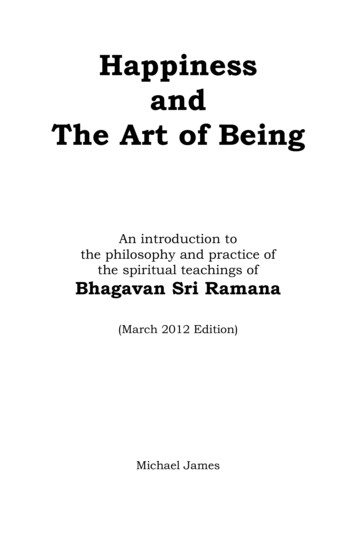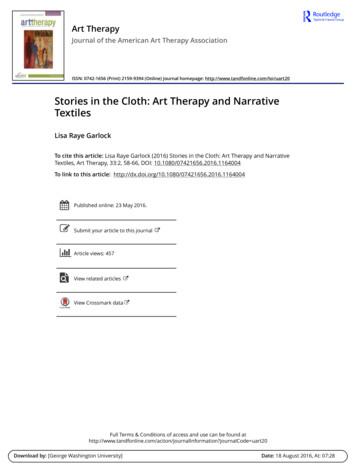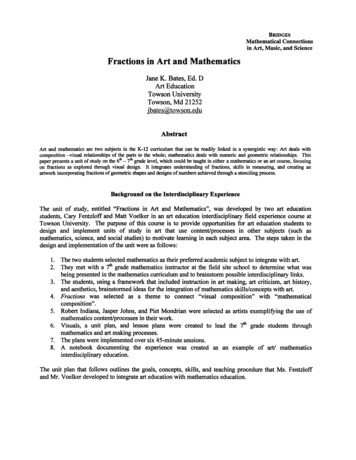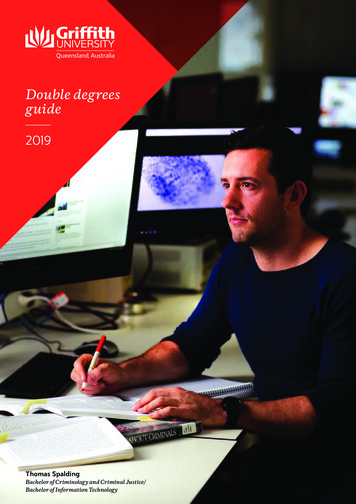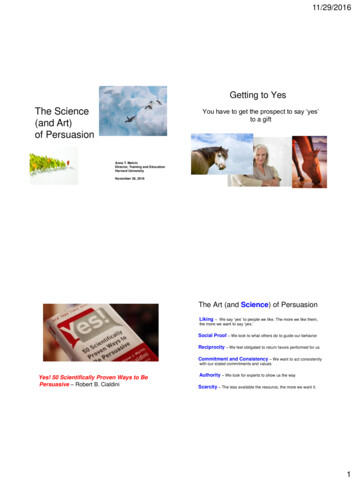
Transcription
11/29/2016Getting to YesThe Science(and Art)of PersuasionYou have to get the prospect to say ‘yes’to a giftAnne T. MelvinDirector, Training and EducationHarvard UniversityNovember 30, 2016The Art (and Science) of PersuasionLiking – We say ‘yes’ to people we like. The more we like them,the more we want to say ‘yes.’Social Proof – We look to what others do to guide our behaviorReciprocity – We feel obligated to return favors performed for usCommitment and Consistency – We want to act consistentlywith our stated commitments and valuesYes! 50 Scientifically Proven Ways to BePersuasive – Robert B. CialdiniAuthority – We look for experts to show us the wayScarcity – The less available the resource, the more we want it.1
11/29/2016What do you want from this talk?The Art (and Science) of PersuasionLiking – We say ‘yes’ to people we like. The more welike them, the more we want to say ‘yes.’Liking - social science experimentRepeat thediner’s orderback to themEXACTLY asthey said it70%increase in tipWhuh .?Matchingcreatesfeelings oflikingMatchingstrengthensthe bondsbetweenpeople2
11/29/2016Liking – social science experimentMirroring – the art“Mirroring” –Negotiationexperiment with MBAstudents67%12.5%Mirroring – “Just the facts, ma’am” BULLET . POINT . STYLE Mirroring - indirect Ahhhhhh 3
11/29/2016Mirroring – the artWords and phrasesAmericans are .The Art (and Science) of PersuasionLiking – We say ‘yes’ to people we like. The more welike them, the more we want to say ‘yes.’Social Proof – We look to what others do to guide ourbehavior4
11/29/2016Social proofHow can ‘social proof’ be true?InfomercialsHumans aresurprisingly poor atunderstanding thefactors that affect ourown behavior.Social proof“Operators arewaiting – please callnow”Social proofInfomercials“If operators arebusy – pleasecall back later”5
11/29/2016Social proof – social science experimentArizonaPetrifiedForestNationalPark6
11/29/2016Social proof – social science experimentSocial proof – social science experimentExistingsigns“Your heritage isbeing vandalizedevery day by theftlosses of petrifiedwood of 14 tons ayear mostly ofsmall pieces at atime.”NEGATIVESOCIAL PROOFSocial proof – social science experimentNEUTRAL SIGN:“Please don’t remove the petrified wood from the park, in orderto preserve the natural state of the Petrified Forest.”NEGATIVE SOCIAL PROOF SIGN:“Many park visitors have removed the petrified wood fromthe park changing the natural state of the Petrified Forest."Social proof – social science experimentNEUTRAL SIGN:“Please don’t remove the petrified wood from the park, in orderto preserve the natural state of the Petrified Forest.”7
11/29/2016Social proof – social science experimentSocial proof – social science experimentNeutralsocial proof signs1.67% wood taken(don’t remove )BAITNegativesocial proof signs7.92% of wood taken(visitors have removed )What should the message be?“98% of visitors leave this park in itsnatural state by taking only pictures,leaving only footprints.”8
11/29/2016Who drives to work on the highway?Social proof – the art of testimonialsSocial ProofSocial proof – the art of the box chartClose as possible to audience you’re trying to reach9
11/29/2016Social proof – the art of the askSocial proof – the art of the bequest ask“Mrs. Hu, thank you for yourgenerous gifts over the years.You’ve been such atremendous and loyalsupporter of ourorganization.You know, many donorswho give as regularly as youhave put our organization intheir will; what are yourthoughts about doing that?”AVOID Negative Social Proof“Only 8% ofclassical musiclisteners give toWCMU radiostation .Please give .”10
11/29/2016The Art (and Science) of PersuasionReciprocity: social science experimentLiking – We say ‘yes’ to people we like. The more welike them, the more we want to say ‘yes.’Social Proof – We look to what others do to guide ourbehaviorReciprocity – We feel obligated to return favorsperformed for usCheck with ONE candyReciprocity: social science experimentCheck with ONE candy3.3% raise in tipCheck with TWO candies14.1% raise in tipCheck with TWO candiesReciprocity: social science experiment23%11
11/29/2016Reciprocity: pump up the volumeReciprocity1. Significance (two is better than one)2. Unexpected (candy after turning away)3. Personalized (‘I’m giving you this second candybecause you were a really nice customer”)Reciprocity – the artReciprocity –the artSmall,personalizedgifts12
11/29/2016Final advice on reciprocity!Commitment and consistency – social science experimentThe Art (and Science) of PersuasionLiking – We say ‘yes’ to people we like. The more we like them,the more we want to say ‘yes.’Control Group:Social Proof – We look to what others do to guide our behaviorReciprocity – We feel obligated to return favors performed for us17% said “Yes”Commitment and Consistency – We want to act consistentlywith our stated commitments and values13
11/29/2016Commitment and consistency – social science experimentCommitment and consistency – social science experimentExperimentalGroup:Experimentalgroup:2 weeks laterMostsaid “Yes”76%said “Yes”Commitment and ConsistencyCommitment and consistency – the artWritten pledges“Can you pleaserespond to thisemail with a 'yes'that it's yourintention to makethe 500 gift wediscussed?"14
11/29/2016Commitment and consistency – the artCommitment and consistency – the art Advisory groups –written report Volunteers – talkabout your org to afriendAsk volunteers to write afundraising letter to theirfriends and follow up withphone callsAsk a low-levelsupporter withpotential to host adinner party/cocktailpartyThe Art (and Science) of PersuasionLiking – We say ‘yes’ to people we like. The more we like them,the more we want to say ‘yes.’Social Proof – We look to what others do to guide our behaviorReciprocity – We feel obligated to return favors performed for usCommitment and Consistency – We want to act consistentlywith our stated commitments and valuesAuthority – We look for experts to show us the way15
11/29/2016Authority – social science experimentAuthority – the artWould you make a 100,000 gift throughthis person?Control group:Experimental group:Casually dressedyoung manSame man in abusiness suitAuthority – When it comes toTRUST and BELIEVABILITY How you appear to theother person What you sound like What you say16
11/29/2016The Art (and Science) of PersuasionScarcity – social scienceLiking – We say ‘yes’ to people we like. The more we like them,the more we want to say ‘yes.’Social Proof – We look to what others do to guide our behaviorReciprocity – We feel obligated to return favors performed for usCommitment and Consistency – We want to act consistentlywith our stated commitments and valuesAuthority – We look for experts to show us the wayScarcity – The less available the resource, the more we want it.Tired old Olds 1988ScarcityOldsmobile announced they were going out of business 2003 – after yearsof flaggingOldsmobile sales Fewer Olds ads No retooling2003BEST SELLING CAR OF THE YEAR17
11/29/2016ScarcityThe Day the Twinkie DiedNov 16, 2012.Scarcity – the art – Jeopardy style!Scarcity – the artSame message, different emphasis"John, if you make a giftof 100,000, you willqualify for the scholarshipmatching challenge,making a total campaigngift of 200,000."Answer:Harvard announced the priceof scholarships was doublingand the old price was onlygood for two more months.“John, only 20% of the challenge matchfunds are left. Several other donors arethinking about using the match. If theydo, I can’t guarantee there will be anymatch left for you. Will you make a gift of 100,000 now to qualify for the match?”Question:How did Harvard Collegequadruple it’s newscholarships in two months(148 new ones)?18
11/29/2016Scarcity – the artplanned giving context“Cynthia, you and Johnqualify for a 6.0%charitable gift annuity.”"Cynthia, right now, you and John qualify for a6.0% charitable gift annuity. In three months, weexpect the gift annuity rates to drop, and I'll onlybe able to offer you and John a rate of 5.7%. Ifyou act before January to establish the annuity,we can set up the annuity at the higher 6.0%rate."LOSSAVERSIONLiking Social ProofCafé CirclesCommitment and Consistency ScarcityReciprocity AuthoritySTAND UP!Pick the technique YOU learned heretoday that YOU think would be mostpersuasive with a donor.Why did we just do that exercise?Tell your colleague about it in30 seconds or less. I’ll time you.Then listen to your colleagues favoritetechnique. 30 seconds or less.Switch partners! Repeat!19
11/29/2016Table WorkQuestions?How can you apply– Liking– Social Proof– Commitment andConsistency– Scarcity– Reciprocity– AuthorityAt your shop, or to PGin generalTables: report outThanks!BonusTracksAnne T. MelvinATM ConsultingAnne.melvin@alumni.williams.edu20
11/29/2016“Magnetic middle”When offered several choices, people opt for theone in the middlePerceptual ContrastThings look different,depending on howthey are presented toyou. 926 854 600Perceptual ContrastRienzi P. and theCRUTMaking perceptual contrast workFOR you Present not-so-goodchoice first Present best choicenext and last Don’t present toomany choices21
11/29/2016FluencyA message that is difficult to decode,pronounce, understand, is less CONVINCINGthan one that is easy.Ex: “If the glove don’t fit, you must acquit!”Disfluency22
11/29/2016Hilliard, Ohio school bond levy“Unite for Kids”“Building Tomorrow Today”“Our Kids Can’t Wait” –fear/loss aversionCommitment and consistency – the art of the askWhat I'm hearing from you,Tish, is that it's importantthat we're able to keepattracting the best studentsacross the state even ifthey, like you, couldn’tafford full tuition. Is thatcorrect? That's SIU’s goaltoo.I’d like for you to considermaking that possible forthe next generation ofstudents with a gift of 25,000."23
11/29/2016Thanks!Anne T. MelvinATM ConsultingAnne.melvin@alumni.williams.edu24
(and Art) of Persuasion Anne T. Melvin Director, Training and Education Harvard University November 30, 2016 Getting to Yes You have to get the prospect to say ‘yes’ to a gift Yes! 50 Scientifically Proven Ways to Be Persuasive –Robert B. Cialdini The Art (and Science) of Persuasion

